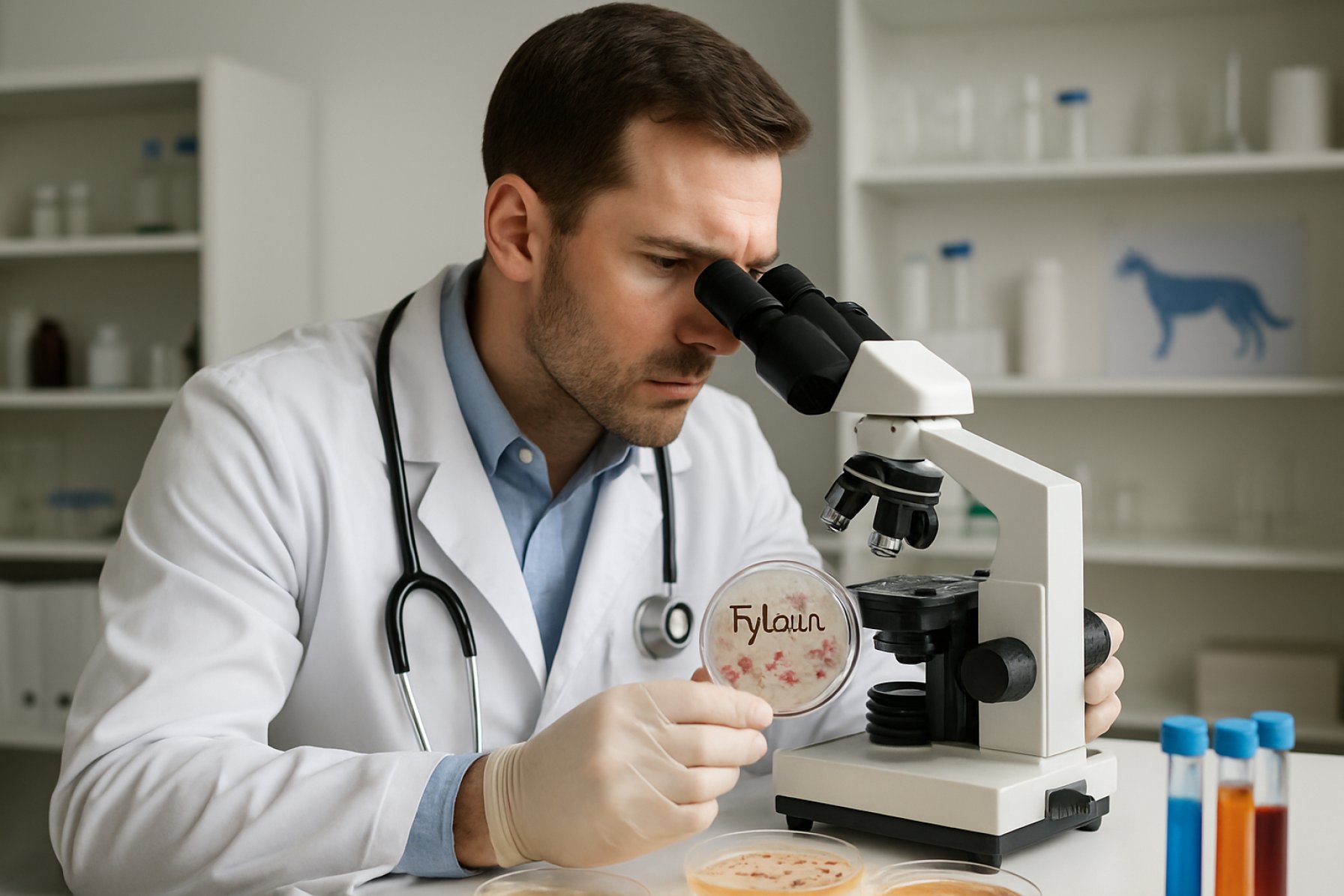Unmasking Tylosin Resistance in Veterinary Microbiology: How Antimicrobial Resistance is Shaping Animal Health and What the Future Holds. Explore the Science, Risks, and Solutions Behind This Growing Challenge. (2025)
- Introduction: The Role of Tylosin in Veterinary Medicine
- Mechanisms of Tylosin Resistance in Bacterial Pathogens
- Prevalence and Geographic Distribution of Tylosin Resistance
- Clinical Implications for Animal Health and Treatment Outcomes
- Detection and Diagnostic Advances for Tylosin Resistance
- Regulatory Perspectives and Guidelines (Referencing oie.int, fda.gov, ema.europa.eu)
- Impact on Livestock Production and Food Safety
- Emerging Technologies and Alternative Therapies
- Market and Public Interest Forecast: Trends and Projections (Estimated 20-30% Increase in Research and Public Attention by 2028)
- Future Outlook: Strategies for Mitigation and Global Collaboration
- Sources & References
Introduction: The Role of Tylosin in Veterinary Medicine
Tylosin is a macrolide antibiotic widely utilized in veterinary medicine, particularly for the treatment and prevention of bacterial infections in livestock such as cattle, swine, and poultry. Its primary mechanism of action involves inhibition of protein synthesis in susceptible bacteria, making it effective against a range of Gram-positive organisms and certain Gram-negative bacteria. Since its introduction in the 1960s, tylosin has played a crucial role in managing respiratory, enteric, and mycoplasmal diseases in animals, contributing significantly to animal health and productivity. In addition to therapeutic applications, tylosin has historically been used as a growth promoter in animal feed, although such practices have been increasingly restricted or banned in many regions due to concerns over antimicrobial resistance (European Medicines Agency).
The widespread use of tylosin in veterinary settings has raised concerns about the emergence and dissemination of tylosin-resistant bacteria. Resistance can develop through various mechanisms, including modification of the antibiotic target site, efflux pumps that expel the drug from bacterial cells, and enzymatic inactivation. These resistance traits can be transferred between bacteria, sometimes even across species, via mobile genetic elements such as plasmids and transposons. The presence of tylosin-resistant pathogens in food-producing animals poses a risk not only to animal health but also to public health, as resistant bacteria or their resistance genes may be transmitted to humans through the food chain or direct contact (World Health Organization).
Recognizing the potential impact of antimicrobial resistance, international organizations such as the World Organisation for Animal Health (WOAH, formerly OIE) and the Food and Agriculture Organization of the United Nations (FAO) have emphasized the prudent use of antibiotics like tylosin in veterinary practice. These organizations provide guidelines and recommendations to minimize the development of resistance, including surveillance programs, restrictions on non-therapeutic use, and promotion of alternative disease control strategies. In 2025, the issue of tylosin resistance remains a significant focus within veterinary microbiology, necessitating ongoing research, monitoring, and coordinated global action to safeguard both animal and human health.
Mechanisms of Tylosin Resistance in Bacterial Pathogens
Tylosin, a macrolide antibiotic widely used in veterinary medicine, is essential for the treatment and prevention of various bacterial infections in livestock and companion animals. However, the emergence and dissemination of tylosin resistance among bacterial pathogens pose significant challenges to animal health and the efficacy of antimicrobial therapies. Understanding the mechanisms underlying tylosin resistance is crucial for developing effective mitigation strategies and guiding prudent antimicrobial use in veterinary settings.
The primary mechanism of tylosin resistance in bacterial pathogens involves modification of the antibiotic’s target site. Tylosin exerts its antibacterial effect by binding to the 50S ribosomal subunit, thereby inhibiting protein synthesis. Resistance often arises through methylation of the 23S rRNA component of the 50S subunit, mediated by erm (erythromycin ribosomal methylase) genes. This methylation reduces tylosin’s binding affinity, conferring cross-resistance to other macrolides and lincosamides. The prevalence of erm genes has been documented in various veterinary pathogens, including Staphylococcus aureus, Streptococcus suis, and Pasteurella multocida.
Another significant mechanism is the active efflux of tylosin from bacterial cells. Efflux pumps, such as those encoded by mef (macrolide efflux) genes, decrease intracellular concentrations of the antibiotic, thereby reducing its efficacy. These efflux systems are particularly relevant in Gram-negative bacteria, where intrinsic and acquired resistance mechanisms can act synergistically. Additionally, mutations in ribosomal proteins (e.g., L4 and L22) or the 23S rRNA itself can alter the antibiotic binding site, further contributing to resistance.
Enzymatic inactivation of tylosin, though less common, has also been reported. Certain bacterial enzymes can hydrolyze or modify the macrolide structure, rendering it inactive. While this mechanism is more frequently associated with other antibiotic classes, its potential role in tylosin resistance warrants continued surveillance.
The genetic determinants of tylosin resistance are often located on mobile genetic elements such as plasmids, transposons, and integrative conjugative elements. This facilitates horizontal gene transfer among bacterial populations, accelerating the spread of resistance within and between animal species. The World Organisation for Animal Health (WOAH) and U.S. Food and Drug Administration (FDA) have highlighted the importance of monitoring antimicrobial resistance genes in veterinary pathogens to inform risk assessments and stewardship policies.
In summary, tylosin resistance in veterinary microbiology is mediated by a combination of target site modification, active efflux, and, to a lesser extent, enzymatic inactivation. The mobility of resistance genes underscores the need for coordinated surveillance and responsible antimicrobial use to preserve the efficacy of tylosin and related macrolides in animal health.
Prevalence and Geographic Distribution of Tylosin Resistance
Tylosin, a macrolide antibiotic widely used in veterinary medicine, has been integral in managing bacterial infections in livestock, particularly in swine, poultry, and cattle. However, the emergence and spread of tylosin resistance among pathogenic and commensal bacteria have become a significant concern in veterinary microbiology. The prevalence and geographic distribution of tylosin resistance are influenced by factors such as antibiotic usage patterns, regulatory frameworks, and local agricultural practices.
Globally, resistance to tylosin has been reported in a variety of bacterial species, including Staphylococcus aureus, Streptococcus suis, Enterococcus faecalis, and Mycoplasma species. In Europe, surveillance data indicate that tylosin resistance is particularly notable in Staphylococcus and Enterococcus isolates from pigs and poultry, with some countries reporting resistance rates exceeding 30% in certain bacterial populations. The European Union, through coordinated monitoring programs, has documented regional differences, with higher resistance rates often observed in countries with historically greater macrolide usage in animal husbandry (European Medicines Agency).
In North America, tylosin resistance is also prevalent, especially in intensive livestock production systems. The United States Department of Agriculture (USDA) and the Food and Drug Administration (FDA) have reported increasing resistance trends in enterococci and other Gram-positive bacteria isolated from food-producing animals. These trends are closely monitored as part of the National Antimicrobial Resistance Monitoring System (NARMS), which highlights regional variability, with higher resistance rates in areas of concentrated animal feeding operations (U.S. Food and Drug Administration).
Asia presents a complex picture, with several countries reporting high levels of tylosin resistance, particularly in poultry and swine production. Studies from China, South Korea, and Vietnam have identified resistance rates in Enterococcus and Streptococcus species that often surpass those reported in Europe and North America. This is attributed to the widespread and, in some cases, unregulated use of tylosin and other macrolides in animal agriculture (World Organisation for Animal Health).
In contrast, data from Oceania and Africa are more limited, but available reports suggest emerging resistance, especially in regions with expanding commercial livestock sectors. The global distribution of tylosin resistance underscores the need for harmonized surveillance and stewardship efforts, as recommended by international organizations such as the World Health Organization and the World Organisation for Animal Health. These bodies emphasize the importance of coordinated action to monitor resistance trends and mitigate the spread of resistant bacteria across borders.
Clinical Implications for Animal Health and Treatment Outcomes
Tylosin, a macrolide antibiotic, has been widely used in veterinary medicine for the treatment and prevention of bacterial infections, particularly in livestock such as cattle, swine, and poultry. Its efficacy against Gram-positive bacteria and certain mycoplasmas has made it a mainstay in managing respiratory, enteric, and systemic infections. However, the emergence and spread of tylosin resistance among pathogenic bacteria present significant clinical challenges, directly impacting animal health and treatment outcomes.
The development of tylosin resistance is primarily attributed to the extensive and sometimes indiscriminate use of the drug in both therapeutic and subtherapeutic (growth promotion) contexts. Resistant strains of Staphylococcus aureus, Streptococcus suis, and various Mycoplasma species have been increasingly reported in veterinary settings. This resistance often results from genetic mechanisms such as target site modification (e.g., methylation of 23S rRNA), efflux pumps, and enzymatic inactivation, which collectively reduce the drug’s efficacy.
Clinically, tylosin resistance can lead to treatment failures, prolonged disease courses, and increased morbidity and mortality in affected animal populations. For example, in swine, tylosin-resistant Mycoplasma hyopneumoniae can compromise the control of enzootic pneumonia, leading to persistent respiratory problems and economic losses. Similarly, in poultry, resistance among Mycoplasma gallisepticum strains can undermine flock health and productivity. These outcomes necessitate the use of alternative, often more expensive or less effective, antimicrobials, which may further drive resistance selection.
The clinical implications extend beyond individual animal health to herd and flock management. Increased prevalence of resistant infections can necessitate changes in biosecurity protocols, vaccination strategies, and overall herd health management. Moreover, the presence of tylosin-resistant bacteria in food-producing animals raises concerns about potential transmission to humans, either through direct contact or via the food chain, contributing to the broader issue of antimicrobial resistance (AMR).
Veterinary authorities and organizations such as the World Organisation for Animal Health (WOAH) and the U.S. Food and Drug Administration (FDA) have emphasized the importance of prudent antimicrobial use and the implementation of antimicrobial stewardship programs to mitigate resistance development. These measures include surveillance of resistance patterns, restriction of non-therapeutic antibiotic use, and promotion of alternative disease control strategies.
In summary, tylosin resistance in veterinary microbiology poses significant clinical implications, affecting treatment efficacy, animal welfare, and public health. Addressing this challenge requires coordinated efforts in surveillance, stewardship, and research to preserve the utility of tylosin and other critical antimicrobials in veterinary practice.
Detection and Diagnostic Advances for Tylosin Resistance
The detection and diagnosis of tylosin resistance in veterinary microbiology have evolved significantly, reflecting the growing need for rapid, accurate, and field-applicable methods. Tylosin, a macrolide antibiotic widely used in veterinary medicine, particularly in food-producing animals, faces increasing resistance among key bacterial pathogens. Early and precise identification of resistant strains is crucial for effective antimicrobial stewardship and for safeguarding both animal and public health.
Traditional detection methods for tylosin resistance have relied on phenotypic assays, such as broth microdilution and agar dilution, which determine the minimum inhibitory concentration (MIC) of tylosin against bacterial isolates. These methods, standardized by organizations like the Clinical and Laboratory Standards Institute (CLSI) and the World Health Organization (WHO), remain the gold standard due to their reliability and reproducibility. However, they are labor-intensive and time-consuming, often requiring 24–48 hours for results.
To address these limitations, molecular diagnostic techniques have gained prominence. Polymerase chain reaction (PCR)-based assays enable the rapid detection of specific resistance genes, such as erm (erythromycin ribosomal methylase) and msr (macrolide efflux) genes, which are commonly associated with tylosin resistance in pathogens like Staphylococcus aureus and Mycoplasma species. Real-time PCR and multiplex PCR platforms allow for simultaneous detection of multiple resistance determinants, significantly reducing turnaround time and increasing throughput.
Advances in whole genome sequencing (WGS) have further transformed resistance surveillance. WGS provides comprehensive insights into the resistome of bacterial isolates, enabling the identification of both known and novel resistance mechanisms. This technology is increasingly accessible due to decreasing costs and improved bioinformatics tools, and is being integrated into national and international surveillance programs coordinated by authorities such as the World Organisation for Animal Health (WOAH, formerly OIE) and the U.S. Food and Drug Administration (FDA). These organizations play a pivotal role in harmonizing diagnostic standards and promoting data sharing across borders.
Emerging point-of-care diagnostics, including isothermal amplification methods and lateral flow assays, are under development to facilitate on-site detection of tylosin resistance, particularly in resource-limited settings. These innovations promise to enhance the speed and accessibility of resistance monitoring, supporting timely clinical decision-making and targeted antimicrobial use.
In summary, the landscape of tylosin resistance detection in veterinary microbiology is rapidly advancing, driven by the integration of molecular, genomic, and point-of-care technologies. Continued collaboration among regulatory bodies, veterinary laboratories, and research institutions is essential to ensure the effective deployment and standardization of these diagnostic tools.
Regulatory Perspectives and Guidelines (Referencing oie.int, fda.gov, ema.europa.eu)
The emergence and spread of tylosin resistance in veterinary microbiology have prompted significant regulatory attention at both national and international levels. Tylosin, a macrolide antibiotic widely used in veterinary medicine, particularly in food-producing animals, is under scrutiny due to its role in selecting for resistant bacterial populations that may compromise animal health and potentially impact public health. Regulatory agencies and international organizations have developed comprehensive guidelines and monitoring frameworks to address these concerns.
The World Organisation for Animal Health (WOAH, formerly OIE) plays a central role in setting global standards for antimicrobial use in animals. WOAH’s guidelines emphasize the prudent and responsible use of antimicrobials, including tylosin, to minimize the development of resistance. The organization maintains a list of antimicrobial agents of veterinary importance and provides recommendations for surveillance, risk assessment, and stewardship programs. WOAH also coordinates the global collection of data on antimicrobial use and resistance, facilitating international collaboration and harmonization of regulatory approaches.
In the United States, the U.S. Food and Drug Administration (FDA) regulates the approval and use of veterinary antimicrobials, including tylosin. The FDA’s Center for Veterinary Medicine (CVM) has implemented policies to promote judicious use, such as requiring veterinary oversight for medically important antimicrobials and phasing out their use for growth promotion in food animals. The FDA also conducts surveillance through the National Antimicrobial Resistance Monitoring System (NARMS), tracking resistance trends in bacteria from animals, retail meats, and humans. These efforts are part of a broader strategy to preserve the effectiveness of existing antimicrobials and protect public health.
Within the European Union, the European Medicines Agency (EMA) is responsible for the scientific evaluation and supervision of veterinary medicines. The EMA, through its Committee for Medicinal Products for Veterinary Use (CVMP), issues guidance on the responsible use of antimicrobials and assesses the risk of resistance development associated with veterinary products. The EMA also coordinates the European Surveillance of Veterinary Antimicrobial Consumption (ESVAC) project, which collects and analyzes data on antimicrobial sales and usage patterns across member states. These data inform regulatory decisions and support the implementation of the EU’s One Health Action Plan against antimicrobial resistance.
Collectively, these regulatory perspectives underscore the importance of coordinated action, surveillance, and stewardship to mitigate tylosin resistance. Ongoing updates to guidelines and monitoring systems reflect the evolving scientific understanding and the need for adaptive regulatory responses in veterinary microbiology.
Impact on Livestock Production and Food Safety
Tylosin, a macrolide antibiotic widely used in veterinary medicine, plays a crucial role in managing bacterial infections in livestock, particularly in swine, poultry, and cattle. However, the emergence and proliferation of tylosin-resistant bacteria have significant implications for both livestock production and food safety. Resistance to tylosin can compromise animal health, reduce productivity, and pose risks to public health through the food chain.
In livestock production, tylosin is commonly administered for the prevention and treatment of respiratory and enteric diseases, as well as for growth promotion in some regions. The development of resistance among pathogens such as Staphylococcus aureus, Enterococcus spp., and Campylobacter spp. can lead to increased morbidity and mortality in herds and flocks. This, in turn, results in economic losses due to decreased weight gain, higher veterinary costs, and increased culling rates. The World Organisation for Animal Health (WOAH)—an intergovernmental authority on animal health—has highlighted the threat posed by antimicrobial resistance (AMR) to sustainable animal production and global food security.
Tylosin resistance also has direct consequences for food safety. Resistant bacteria can be transmitted from animals to humans through the consumption of contaminated meat, milk, or eggs, or via direct contact with animals. The Food and Agriculture Organization of the United Nations (FAO) and the World Health Organization (WHO) have both emphasized that the presence of antimicrobial-resistant bacteria in the food supply chain increases the risk of treatment failures in human medicine, as some resistance genes can be transferred to human pathogens. This is particularly concerning for vulnerable populations and in settings where alternative antibiotics are limited.
To mitigate these risks, international organizations such as WOAH, FAO, and WHO advocate for prudent use of antimicrobials in veterinary practice, robust surveillance of resistance patterns, and the implementation of good agricultural and hygiene practices. These measures are essential to preserve the efficacy of tylosin and other critical antibiotics, safeguard animal health, and protect public health by ensuring the safety of animal-derived food products.
Emerging Technologies and Alternative Therapies
The growing challenge of tylosin resistance in veterinary microbiology has prompted significant research into emerging technologies and alternative therapies aimed at mitigating antimicrobial resistance (AMR) in animal health. Tylosin, a macrolide antibiotic widely used in veterinary medicine, particularly in food-producing animals, has seen diminishing efficacy due to the proliferation of resistant bacterial strains. This trend has spurred innovation in both diagnostic and therapeutic approaches to address the issue.
One of the most promising technological advancements is the development of rapid molecular diagnostics. These tools, such as polymerase chain reaction (PCR) assays and next-generation sequencing (NGS), enable the swift identification of resistance genes in bacterial isolates from animals. By providing veterinarians with real-time data on the presence of tylosin resistance, these diagnostics facilitate more targeted and judicious use of antimicrobials, reducing unnecessary exposure and selection pressure. Organizations like the World Organisation for Animal Health (WOAH) and the U.S. Food and Drug Administration (FDA) have emphasized the importance of such technologies in their AMR surveillance and stewardship programs.
Alternative therapies are also gaining traction as viable strategies to combat tylosin resistance. One approach involves the use of bacteriophage therapy, which employs viruses that specifically target and lyse antibiotic-resistant bacteria. Early studies suggest that phage therapy can be effective against pathogens that no longer respond to tylosin, offering a precision tool with minimal impact on the broader microbiome. Additionally, the application of probiotics and competitive exclusion products is being explored to enhance gut health and outcompete pathogenic bacteria, thereby reducing the need for antibiotics like tylosin.
Another area of innovation is the development of immunomodulators and vaccines designed to prevent infections that would otherwise require tylosin treatment. By bolstering the animal’s immune response or directly targeting specific pathogens, these interventions can decrease reliance on antibiotics and slow the spread of resistance. The European Medicines Agency (EMA) and other regulatory bodies are actively evaluating the safety and efficacy of such alternatives as part of broader AMR action plans.
Finally, advances in precision livestock farming—such as sensor-based health monitoring and artificial intelligence-driven decision support—are enabling earlier detection of disease and more precise administration of therapeutics. These technologies, supported by international organizations and national regulatory agencies, represent a holistic approach to reducing tylosin use and curbing resistance in veterinary settings.
Market and Public Interest Forecast: Trends and Projections (Estimated 20-30% Increase in Research and Public Attention by 2028)
The growing concern over antimicrobial resistance (AMR) in veterinary medicine has placed tylosin resistance at the forefront of both scientific research and public discourse. Tylosin, a macrolide antibiotic widely used in livestock for therapeutic and prophylactic purposes, has been increasingly scrutinized due to the emergence of resistant bacterial strains. This scrutiny is expected to intensify, with projections indicating a 20-30% increase in research activity and public attention related to tylosin resistance by 2028.
Several factors are driving this trend. First, regulatory agencies and international organizations, such as the World Organisation for Animal Health (WOAH) and the Food and Agriculture Organization of the United Nations (FAO), have prioritized AMR surveillance and mitigation strategies. These organizations have issued guidelines and recommendations for prudent antibiotic use in animals, directly influencing research funding and policy development. The World Health Organization (WHO) has also highlighted the risks associated with veterinary antibiotic resistance, emphasizing the potential for zoonotic transmission and the impact on human health.
Market trends reflect this heightened awareness. Pharmaceutical companies and diagnostic firms are investing in the development of rapid detection methods for tylosin-resistant pathogens, as well as alternative therapies and vaccines. The demand for such innovations is expected to rise as regulatory frameworks tighten and consumer awareness grows. Additionally, academic and governmental research institutions are expanding surveillance programs to monitor resistance patterns in both developed and emerging markets.
Public interest is also projected to increase, fueled by advocacy from non-governmental organizations and consumer groups concerned about food safety and sustainable agriculture. Educational campaigns and media coverage are likely to amplify calls for transparency in antibiotic usage and the adoption of best practices in animal husbandry. This societal pressure is anticipated to further stimulate research and policy initiatives aimed at curbing tylosin resistance.
In summary, the intersection of regulatory action, market innovation, and public advocacy is expected to drive a significant uptick in both research output and societal engagement with the issue of tylosin resistance in veterinary microbiology. By 2028, stakeholders across the veterinary, agricultural, and public health sectors will likely be more actively involved in addressing this challenge, reflecting a broader commitment to combating antimicrobial resistance on a global scale.
Future Outlook: Strategies for Mitigation and Global Collaboration
The future outlook for addressing tylosin resistance in veterinary microbiology hinges on the implementation of robust mitigation strategies and enhanced global collaboration. As tylosin, a macrolide antibiotic, continues to be widely used in animal agriculture, the emergence and spread of resistant bacterial strains pose significant challenges to both animal and public health. To counteract these threats, a multifaceted approach is essential.
One of the primary strategies involves the prudent and judicious use of tylosin in veterinary practice. This includes adhering to evidence-based guidelines for antibiotic administration, limiting use to cases where it is medically necessary, and avoiding its application as a growth promoter. Regulatory agencies such as the European Medicines Agency and the U.S. Food and Drug Administration have already implemented restrictions and guidance to reduce non-therapeutic use of antibiotics in food-producing animals. These measures are expected to be further refined and harmonized globally in the coming years.
Surveillance and monitoring systems are critical for tracking the prevalence and dissemination of tylosin-resistant bacteria. International organizations like the World Organisation for Animal Health (WOAH) and the World Health Organization advocate for integrated surveillance programs that encompass both animal and human health sectors, in line with the One Health approach. Enhanced data sharing and standardized reporting protocols will facilitate early detection of resistance trends and inform targeted interventions.
Research and development of alternative therapies and preventive measures are also gaining momentum. Vaccination, improved biosecurity, and the use of probiotics or competitive exclusion products are being explored as means to reduce reliance on antibiotics like tylosin. Collaborative research initiatives, often supported by governmental and intergovernmental agencies, aim to accelerate the discovery of novel antimicrobials and resistance mitigation technologies.
Global collaboration remains a cornerstone of effective resistance management. The Food and Agriculture Organization of the United Nations, together with WOAH and WHO, leads international efforts to coordinate policies, share best practices, and provide technical assistance to countries with limited resources. These partnerships are vital for harmonizing regulatory frameworks, fostering capacity building, and ensuring equitable access to diagnostic and surveillance tools.
In summary, the future of combating tylosin resistance in veterinary microbiology will depend on sustained commitment to stewardship, innovation, and international cooperation. By integrating these strategies, the global community can work towards preserving the efficacy of tylosin and safeguarding both animal and human health.
Sources & References
- European Medicines Agency
- World Health Organization
- Food and Agriculture Organization of the United Nations
- Clinical and Laboratory Standards Institute
- World Health Organization
- World Organisation for Animal Health







